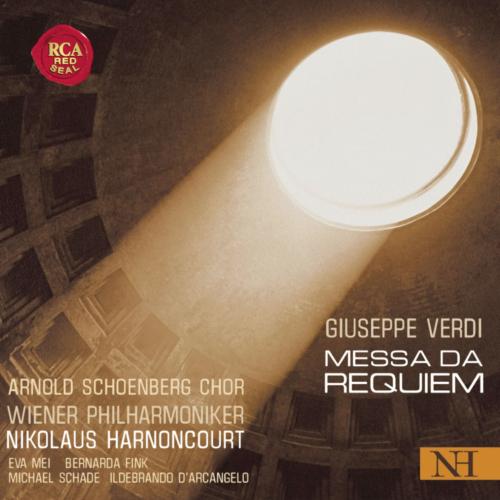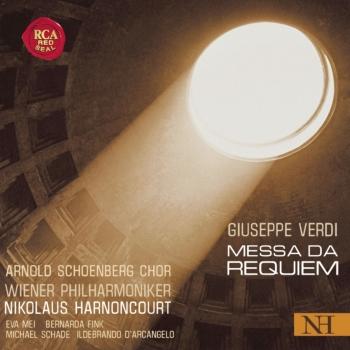
Album info
Album-Release:
2005
HRA-Release:
10.03.2023
Label: RCA Red Seal
Genre: Classical
Subgenre: Vocal
Artist: Arnold Schoenberg Chor, Wiener Philharmoniker & Nikolaus Harnoncourt
Composer: Giuseppe Verdi (1813-1901)
Album including Album cover
I`m sorry!
Dear HIGHRESAUDIO Visitor,
due to territorial constraints and also different releases dates in each country you currently can`t purchase this album. We are updating our release dates twice a week. So, please feel free to check from time-to-time, if the album is available for your country.
We suggest, that you bookmark the album and use our Short List function.
Thank you for your understanding and patience.
Yours sincerely, HIGHRESAUDIO
- Giuseppe Verdi (1813 - 1901): Messa da Requiem: I. Requiem (e Kyrie):
- 1 Messa da Requiem: I. Requiem (e Kyrie): Requiem aeternam 08:36
- Messa da Requiem: II. Dies irae:
- 2 Messa da Requiem: II. Dies irae: Dies irae 02:34
- 3 Messa da Requiem: II. Dies irae: Tuba mirum 03:32
- 4 Messa da Requiem: II. Dies irae: Liber scriptus 05:20
- 5 Messa da Requiem: II. Dies irae: Quid sum miser 03:51
- 6 Messa da Requiem: II. Dies irae: Rex tremendae 03:38
- 7 Messa da Requiem: II. Dies irae: Recordare 04:18
- 8 Messa da Requiem: II. Dies irae: Ingemisco tamquam 03:43
- 9 Messa da Requiem: II. Dies irae: Confutatis maledictis 05:57
- 10 Messa da Requiem: II. Dies irae: Lacrimosa 05:46
- Messa da Requiem: III. Offertorio:
- 11 Messa da Requiem: III. Offertorio: Domine Jesu 04:52
- 12 Messa da Requiem: III. Offertorio: Hostias 05:58
- Messa da Requiem: IV. Sanctus:
- 13 Messa da Requiem: IV. Sanctus: Sanctus 03:01
- Messa da Requiem: V. Agnus Dei:
- 14 Messa da Requiem: V. Agnus Dei: Agnus Dei 04:55
- Messa da Requiem: VI. Lux aeterna:
- 15 Messa da Requiem: VI. Lux aeterna: Lux Aeterna 06:29
- Messa da Requiem: VII. Libera me:
- 16 Messa da Requiem: VII. Libera me: Libera me 02:39
- 17 Messa da Requiem: VII. Libera me: Dies irae 05:41
- 18 Messa da Requiem: VII. Libera me: Libera me (Reprise) 06:50
Info for Verdi: Requiem
When Nikolaus Harnoncourt deals with a landmark in music history, he does not do so without a fundamental reassessment of the music. Here, too, the original sources have been consulted and Verdi's subtleties in instrumentation and vocal technique have been revived to give the interpretation an authenticity that is otherwise disregarded - indeed, all too often shouted down by the bombast of many a performance. In this live recording of this musical star hour from December 2004 from the Vienna Musikverein, hand-picked soloists such as Eva Mei, Bernarda Fink, Michael Schade and Ildebrando d'Arcangelo as well as the renowned Arnold Schoenberg Choir sing under the direction of Nikolaus Harnoncourt and accompanied by the Vienna Philharmonic Orchestra. A (listening) experience of a special kind!
Notes on the score and the performing practice:
The Milan publishers Ricordi brought out a facsimile reprint of the autograph score in 1941. The present recording follows the text of the new critical edition by David Rosen (University of Chicago Press/Ricordi, Milan 1990) as part of the Complete Verdi Edition, WGV III/1. This also contains appendices with the earlier version of the Libera me and the Liber scriptus, but these have not been used for this recording. Rosen draws particular attention to the matter of the instrument to be used for the lowest brass part as a question to which there is no clear answers. The composer himself wanted an instrument for this part that, as he said in a letter to Ricordi on 24th December 1871, "will blend it whith the others" (by which he meant the other trombones). He was particularly allergic to the bass bombardon, which was often used as e replacement for the ophicleide that was gradually disappearing from orchestras in the second half of the 19th century. This prompted Nikolaus Hernoncourt to use not a tuba, as is generally done todey, her instead the bass valve trombone now generally used for the cimbasso parts in Verdi's operas.
In his performing practice Hernoncourt paid particular attention to the fact that Verdi evolved his highly differentiated instructions on dynamics not from the forte, as is customary nowadays, but from a state of silence. Moreover, surveys here shown that the exaggerated portamento so beloved of today's singers was not actually desired by Verdi at all. Thus the soloists do not use portamento here unless the score specifically calls for it. The chorus should be particularly strong in numbers in the middle parts. What Verdi wrote about Aida doubtless applied to the Requiem as well: he wanted "to achieve the colossal volume of sound hat moderates the shrill sound of the sopranos". Verdi's frequently ignored instruction to heve certain passages sung by only four choral singers to a part was likewise strictly followed here.
Originally, the long Dies irae was followed in the lityrgy by the gospel and the sermon; Verdi accordingly always took a longer break when performing the work in a concert hall, for practical reesons if nothing else. This gave time to change around the choir for the double-choir layout that the Sanctus called for - which, incidentally, was an obvious reference to the passage in the Book of Isaiah where "duo seraphim" recite the hymn of praise to each other from different clouds. This recording is spread over two CD’s, doing justice to Verdi's division into two parts of 45 and 40 minutes lenght respectively - something often neglected nowadays.
Eva Mei, soprano
Bernarda Fink, mezzo-soprano
Michael Schade, tenor
Ildebrando d'Arcangelo, bass
Vienna Philharmonic Orchestra
Arnold Schoenberg Choir
Nikolaus Harnoncourt, conductor
Live recording from the Vienna Musikverein from December 2004.
Nikolaus Harnoncourt
Born in Berlin, the Austrian conductor Nikolaus Harnoncourt spent his childhood and youth in Graz, where he grew up in the Meran Palace. His father was a scion of the de la Fontaine-d’Harnoncourt-Unverzagt family, Counts of Luxembourg and Lorraine, his mother the great-granddaughter of Archduke Johann of Styria.Heeding his early artistic ambition, he ultimately preferred to study cello at the Vienna Academy of Music. He joined the Vienna Symphony Orchestra as a cellist in 1952. A year later he founded the Concentus Musicus Wien together with his wife Alice, to provide a forum for his increasingly intensive work with period instruments and Renaissance and baroque musical performance tradition.
Nikolaus Harnoncourt collected historical instruments and, in addition to his performing and conducting activities, devoted his time to his philosophical analyses of “Musik als Klangrede” (“music as speech”), which have to date remained the seminal works on the performance of early music, the key to an entire universe of forgotten works and musical experiences buried under the sands of time.
From 1972 Nikolaus Harnoncourt taught performance practice and the study of historical instruments at the Mozarteum University of Music and Dramatic Arts in Salzburg, while at the same time enjoying growing success as an opera conductor. His debut at the Theater an der Wien with Monteverdi’s “Il ritorno d’Ulisse in patria” in 1971 was followed by the now legendary cycle of Monteverdi operas, which he developed in collaboration with Jean-Pierre Ponnelle, director at the Zurich Opera House, and which was universally acclaimed as a sensational breakthrough. This cycle was followed by an equally exemplary and ground-breaking cycle of Mozart operas, again at the Zurich Opera House and again in partnership with Ponnelle. Nikolaus Harnoncourt’s career as a conductor of both orchestral works and opera encompasses Viennese Classicism, the Romantic repertoire and works from the 20th century. Some milestones are a Mozart cycle at the Vienna State Opera, the Salzburg Festival with mit Monteverdi’s “L’incoronazione di Poppea” and Mozar’s “Le nozze di Figaro”, “Don Giovanni” and “La clemenza di Tito”. In between, he repeatedly returned to Zurich with Weber’s “Freischütz”, Schubert’s “Des Teufels Lustschloss” and “Alfonso und Estrella”, Offenbach’s “La belle Hélène”, “La Périchole” and “La Grande-Duchesse de Gérolstein”, or Verdis “Aida”. With the Concertgebouw Orchestra of Amsterdam, the Chamber Orchestra of Europe, and the Vienna and Berlin Philharmonic Orchestras, Nikolaus Harnoncourt constantly reinterpreted and rediscovered the grand repertoire of orchestral works: the concertos and symphonies of Haydn and Mozart, Beethoven, Mendelssohn, Schubert, Schumann, Brahms, Dvorák and Bruckner, but also the works of Bela Bartók and Alban Berg.
A central venue for many of these projects has been the styriarte Festival, founded in 1985 to establish a closer link between Nikolaus Harnoncourt and his home city of Graz. This is also where he first conducted Schuman’s “Genoveva”, the Prelude and Liebestod from Wagner’s “Tristan and Isolde” and, in 2001, Verdi’s “Requiem”. In 2003 these were followed by the first scenic production of an opera with Offenbach’s “La Grande-Duchesse de Gérolstein” and by Bizet’s “Carmen” in the year 2005. In 2008 Nikolaus Harnoncourt not only conducted but also directed an opera in Graz: Mozart’s “Idomeneo”, which was highly acclaimed by national and international media (“once-in-a-hundred-years event”, Frankfurter Rundschau). In 2009, he proved to even have “the blues running through his veins” (Die Welt) with a highly acclaimed production of Gershwin’s “Porgy and Bess”, in 2011 he conducted in Graz a sensational production of “The Bartered Bride” (Smetana), followed by Offenbach’s “Barbe-Bleue (Bluebeard)” in 2013. And 2014 he traced back to baroque music as he brillantly realised a scenic production of Purcell’s “The Fairy Queen”. Nikolaus Harnoncourt will always be one of the few true stars among conductors worldwide. Performances like the New Year’s Concert of the Vienna Philharmonic Orchestra (2001, 2003) enabled him to reach an audience of millions, displaying the characteristic passion and fiery intensity that identify him, first and foremost, as a true servant of his art.
On December 5th, 2015 Nikolaus Harnoncourt informed his audience in an open letter that he will immediately retire from stage. Only three months later, on March 5th, 2016, he died, surrounded by his family, at the house at Attersee.
This album contains no booklet.










